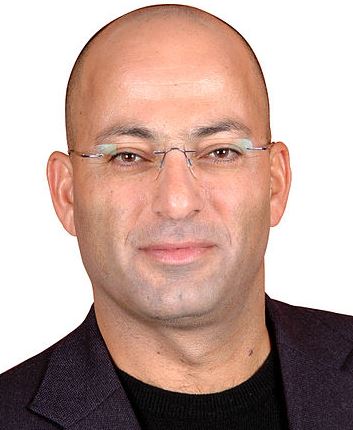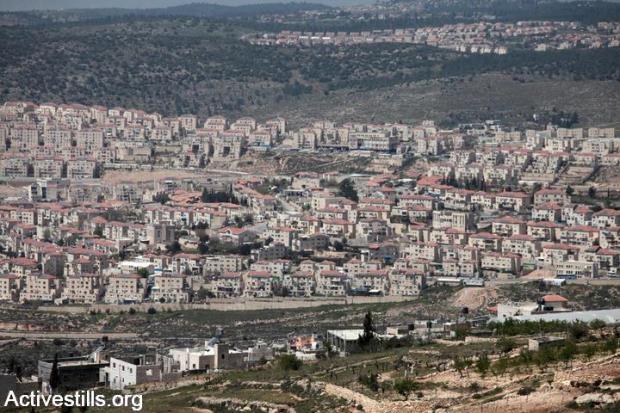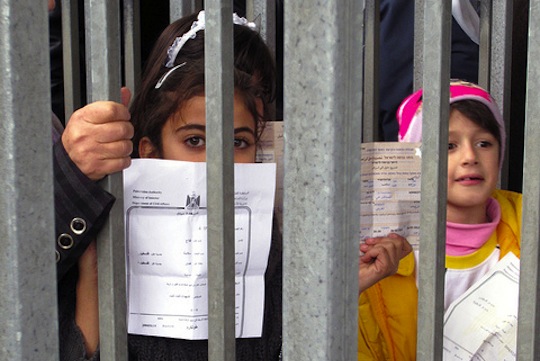Veteran Israeli negotiator Shaul Arieli discusses the failure of the Oslo Accords, various Israeli prime ministers’ commitment (or lack thereof) to ending the occupation, and the only solution he believes both sides could live with, however unsatisfied they might be with it.
Shaul Arieli is a man on a dual mission: educating Israelis about the conflict and diplomatic process with the Palestinians, and making the point that the two-state solution is both possible and necessary. His latest publication in Hebrew, A Border between Us and You (Yeditoth Ahronoth Books 2013), is a 500-page handbook to the history of the conflict, with an emphasis on the diplomatic and political process. It is written in very simple (and sometimes simplistic) language, with lots of maps, tables and even entries describing notable leaders on both sides. Arieli was thinking about Israeli teenagers when he wrote his book, but lately I find myself going back to it again and again to find a figure or to check historical details for one of my posts.
I asked Shaul Arieli for an interview in order to gain more first-hand knowledge and analysis of the history of the negotiations, including what’s really behind terms like “settlements blocs” and “land swaps.” Lately, the mere idea of talks has been put under scrutiny (much of it justified, in my opinion), so I wanted to know what went wrong in the past, and have we, as some claim, “passed the point of no return” with regards to the two-state solution (check out, for example, this piece by Ben Birnbaum in TNR).
Arieli, 54, is the seventh son of Jews who emigrated from Iran. He served in various roles in the IDF, the last one being the commander of Gaza’s Northern Division before and during the first Oslo Accord, a position he left in order to serve in the negotiating team that was formed in Prime Minister Rabin’s office. He took part in negotiations under Netanyahu (in his first term) and Barak. Ariel Sharon stopped the diplomatic process, and Arieli joined the Geneva Accord – an informal agreement between PLO leaders and Israeli negotiators, which has since taken the form of an advocacy organization.
Arieli is a member of The Council for Peace and Security, an Israeli think tank dedicated to advancing a settlement with the Palestinians. He is also the author of nine books on the conflict. He has led hundreds of tours of the West Bank, separation barrier and East Jerusalem to Israeli politicians, diplomats, businessmen and activists. Lately, he made the news after Yair Lapid prevented his party members from going on one of Arieli’s tours to East Jerusalem, claiming that “our party opposes a division of the city.”
***
Of all the Israeli prime ministers you served under or observed, who came closest to a final status agreement?
Rabin, Shimon Peres, Ehud Barak and Ehud Olmert wanted to reach an agreement (even if Barak denies it today). Sharon didn’t believe in agreements. I had the chance to see the way prime ministers matured in their positions. The dramatic changes took place with Barak and Olmert – by the time negotiations broke they were in a very different place. The only leader who was negotiating something real, something possible, was Olmert [in Annapolis]. But it was too late in his term, when he was almost a lame duck. Olmert internalized the concept of reciprocity. Barak never did, and Rabin was in a different era. He didn’t have the chance to end the process.
Did the Palestinians refuse?
I will quote Olmert himself: the Palestinians never refused. They didn’t accept some of our proposals, just as we didn’t accept some of theirs. Israelis think that Olmert gave “a generous offer” to the Palestinians. But the Palestinians would say the same. Mahmoud Abbas was ready for land swaps that would leave 75 percent of the settlers under Israeli authority, including in neighborhoods in East Jerusalem. Abbas went a long way toward Israel on every issue.
Where do you think Netanyahu stands?
Olmert was able to set the four terms of reference that the international community would agree to: a relatively demilitarized Palestinian state (the Palestinians want “a state with limited arms” but the idea is similar), 1967 borders, partition in Jerusalem, and a return to the Palestinian state and not to Israel proper.
Then Netanyahu came, and he had tremendous experience and knowledge on these issues. After all, he took pride once in his ability to kill the Oslo process. I served under Netanyahu and I think he still believes in what he wrote in his book in 1995 – that ‘placing a PLO state 15 km from the beach of Tel Aviv poses an existential threat to the state of Israel.’
Netanyahu, when he came back to office in 2009, didn’t try to introduce his own demands. He went to changing the terms of reference. He declared that 1967 borders won’t serve as basis for the negotiations, and if he accepts land swaps, it will never be in a 1:1 ratio. He wants to annex 10 percent of the West Bank and give the Palestinians 1 percent in return. The same goes for Jerusalem. As long as he continues to speak about a united Jerusalem, anything he might say about the two-state solution is meaningless.
Bibi is the one who moved back from what was agreed upon. There is no reason to enter negotiations without the principles that were agreed upon, without the framework.
Netanyahu wants the process, not the agreement. Bibi doesn’t care about the Palestinians. He is interested in the way Israel is treated by the world. So he will take his time, and as far as he is concerned it [the talks] can take forever.”
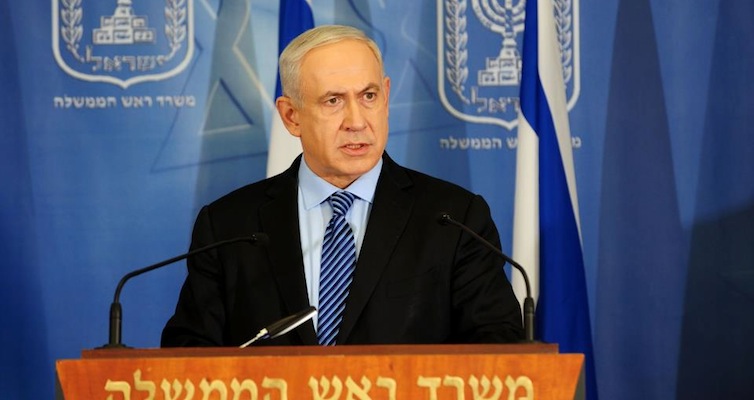
Over half a million Israeli Jews live beyond the Green Line – almost one in every ten Israelis. Leaving the negotiations and other political problems aside, what makes you think that a solution based on the 1967 borders is still possible?
Let’s examine the numbers. 85 percent of the Israelis living east of the Green Line are in the settlements blocs, on a territory which is less than 6 percent of the West Bank. In the triangle around Jerusalem alone, there are 80 percent of the Jews living beyond the Green Line. The biggest city east of the Green Line is [the ultra-Orthodox] Modi’in Ilit, with 54,000 people. That’s 10 percent of the settlers, right on the Green Line. Together with the another ultra-Orthodox city nearby, Beitar Ilit, that’s 100,000 people. The much-debated Ariel is actually the smallest town in the West Bank, not the biggest.
Another third of the settlers [outside annexed East Jerusalem] are secular Jews, who sit in mostly secular settlements like Ma’aleh Edomim, the Jordan Valley and so on. Seventy-five to 80 percent of them will remain under Israeli sovereignty.
The problem is the remaining third. These are the ideological, and they settled in places which were meant to prevent Palestinian contingence. Most of their settlements are near road 60, which crosses the Occupied Territory from north to south. Seventy of those settlements have less than 2,000 people in them. More than 60 percent of those settlers will have to be evacuated. These are the people of Gush Emunim, and with them it won’t be just an ideological struggle, it’s also the struggle over their homes.
When we speak about 1:1 land swaps, that includes East Jerusalem too, right?
Yes. The annexation wasn’t recognized by the international community. Not even by the United States.
Can Israel keep that 6 percent you mentioned in 1:1 land swaps?
It’s a problem. The 6 percent include Ariel and Kdumin, which go 21-23 km into the Green Line, and cut the Shomron [the northern West Bank] in two. Furthermore, coming up with 6 percent of land on the western side of the Green Line [to hand over to the Palestinians] will be impossible. 3-4 percent is probably the upper limit.
So Ariel and Kdumin will have to be evacuated?
Kdumim – yes. With Ariel, evacuation is very likely but it’s not inconceivable that it will remain in Israeli hands. Its price in land swap will be very high though.
At the end of the day, we are talking about evacuating one percent of the Israeli population. Do the other 99 percent agree to be captive to the interests of the 1 percent? To sell their future for the future of the 1 percent? I am sure that if the government went for a real deal, it will still have the support of 70-80 percent of the public.
How much of the West Bank is now annexed de-facto to Israel by the security barrier (the Separation Wall)?
The planned path is leaving 8 percent of the West Bank west of it, ‘on the Israeli side’. But the barrier is not completed, so currently it’s 4.5 percent.
What is the solution for the refugee problem which was negotiated?
Israel never recognized the right of return, and the Palestinian will never give it up. So there should be a distinction between the recognition and the actual return. Israel will need to recognize its share in the responsibility for the suffering the Palestinians have gone through. Regarding the actual return, in Annapolis Israel offered 25,000 people, and the Palestinians wanted 100,000. By the way, it was Olmert who put forward this number, while Livni refused to have even a single refugee enter Israel. The number 100,000 relates to the historical agreement by Israel in Lausanne, 1949, to receive 100,000 refugees. Obviously, this is a number Israel can live with.
The refugees are the strongest bargaining chip the Palestinians have, but I believe that what’s really important for them in the negotiations is land. Compromise is possible.
Is there a point of no return in Jerusalem?
The real threat is the attempt [currently taking place – N.S.] to build projects for Jews inside the Palestinian neighborhoods. The projects in Jabel Mukaber and Mount Scopus are a real threat to the two-state solution. But even if those are completed, we could end up with a solution of an international regime in the city.
So what is the point of no return for the two-state solution?
I don’t think it’s a point in the land. It’s a political decision, on both sides. You can see the emergence of such a decision among young Palestinians, especially those who live abroad or have western orientation – to change the resistance into a human rights battle for civilian rights within the State of Israel. On the Israeli side, a decision to formally annex the West Bank could mark such a point.
Will a two-state solution really satisfy both sides?
[Historically] both sides wanted the entire land to themselves, and I discuss this fact in my book. So in terms of national narratives, there is no room for a common denominator. But [Security Council Resolution] 242, following the Six-Day War, gave a diplomatic way around that. It showed that settlement is possible without accepting the other side’s narrative.
I don’t talk about peace agreements. I discuss final agreements. A new reality that gives every side something but not everything. Both sides need to be very modest in their desires for the final agreements.
So why does the Israeli public believe that an agreement is impossible?
It’s an emotional result of the second Intifada, which was accompanied by declarations like Ehud Barak’s about the fact that ‘there is no partner.’ Those chipped away at Israeli trust dramatically. Needless to say, the Palestinians lost all trust in the Israelis too […] Khaled Mashaal famously told the PLO that 20 years of negotiations with Israel didn’t get a single shoe of a single settler out of the occupied territory. ‘You need to tell the Arab people’ – Hamas says to Fatah – ‘that moving from armed struggle to negotiations was a failure. Israel doesn’t understand anything but force.’
The Jewish public also believes that PLO is temporary and that Hamas will soon take over with a vision of a single Arab land on the entire territory. But the public fails to understand that by holding on to such views, it aids Hamas.
The third problem is the regional changes, and the fear that those changes will lead to Islamic regimes in the area that cannot be negotiated with. Here also, the public doesn’t distinguish between the real and imagined threats.
And on top of everything, there is a feeling of power. That our way is actually working. Take a look – the West Bank is quiet. Israelis feel that they were able to win the psychological battle in the second Intifada.
But things are really quiet.
This is not because of IDF operations. There were more casualties after the Israeli invasion of the West Bank cities in 2003 than before. What stopped the casualties was the security coordination with the Palestinian Authority, which was based on mutual interests. This could all end in a second.
Some people on the right think that Israel should annex the West Bank and give Palestinians Israeli citizenship – sort of a rightwing version of the one-state solution. What are your thoughts on this issue?
The people you are referring to are ignoring 40 percent of the Palestinians who live in Gaza. 1.8 million people who are left outside. Annexing the West Bank will make Hamas the sole representative of the diaspora, and it will continue the struggle from Gaza.
I don’t believe in the binational model. The economical gap is huge. Also, what will become of the refugees? The Palestinians will not forget them – they will demand a return to the unified state. The Jewish elite will flee the country, and you will be left with a poor, religious Jewish minority inside a Palestinian state. I don’t accept this model.
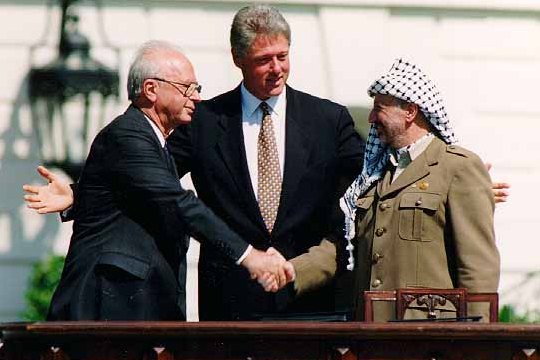
What went wrong in Oslo?
First, the expectations of the sides were very different. The Palestinians felt that they gave up all they could until Oslo, and now they should get something in return. We felt that we gave our concessions by recognizing the PLO, and now we should get more. When I prepared the negotiation file for Ehud Barak I wrote under ‘The Goal’: Establishing a Palestinian state on in the West Bank based on resolution 242. But he wouldn’t have it. He said – our goal is to reach a just partition of the West Bank. In other words, the Israeli willingness to fully implement 242 was very limited.
Furthermore, despite that fact that the first agreement stated that both sides cannot undertake steps that would affect the final status agreement – and that meant most of all construction – Israel went into a frenzy of establishing facts on the ground. The numbers tell the story here: from 109,000 settlers in 1993 we got up to 340,000 today. This was a totally conscious effort. Israel tried to increase the territories of the settlements as much as possible.
Arafat, on the other hand, didn’t understand that he was really perceived as the sole responsible representative for the entire Palestinian people. He allowed Hamas to topple the agreement. He thought that he could contain Hamas, but he gave it the chance to make the agreement fail.
You ask the Israeli public to move into a framework of a “win win” situation instead of a zero-sum game. Could you explain that?
The first half of the 20 century was a zero-sum game, when every side understood that each victory could only be made at the expense of the other side. Even in the negotiations, at the beginning, our feeling was that anything the Palestinians gain is at our expense.
What does a “win win” situation mean? That if I can help the other side create a stable reality, something he could really live with, my interest is satisfied too. It goes the other way too: we can use all our power to force on the Palestinians Israeli enclaves all over the West Bank [whithin the framework of a final status agreement – N.S.], even if I am able to pull this off, I will be sowing the seeds of the next disaster.
Today the second Oslo accord and the Paris protocol, which you worked on, are perceived by many not as a peace agreement but as a mechanism for control over the Palestinian population. They have become a sort of “final status” agreement, which for the Palestinians are much worse than the situation prior to Oslo.
You are absolutely right. But none of us believed that we are heading to another 20 years under those agreements. We thought that the autonomy would last five years at most, and we knew that the Palestinians at the time lacked some capacities. For example, they couldn’t establish their own financial clearing house so Paris had it done through Israel.
But as a permanent agreement, Paris isn’t fair towards the Palestinians.
Of course it isn’t! Of course! Look, the Palestinians really saw the Oslo agreement as an intermediate period. They really thought of Area C [left under Israeli control- N.S.] as a deposit.
Here is a story to illustrate this point: when we drew the maps on the intermediate agreement we did it by hand, so there were a few mistakes done. After the agreement was signed, we asked for several minor changes in the map, mainly due to requests by the settlers to Rabin. I went to Abu Alaa (Ahmed Qurei) with four such changes, but he would hear none of it. So we all went to meet Arafat at the Muqatah. Arafat hears it and says to Abu Alaa: ‘if this is what Rabin needs to make his public accept the agreement, sign it! This is a territory we would get in the final status agreement.’ The thinking that Area C is Israel’s is complete nonsense.
What bothers you most when you examine the situation today?
The occupation itself. It’s hard to put it in words. What it is. The lack of rights. the lack of freedom of movement. Taking away their future, the right of citizenship. I know it sounds dry, but when you meet it every day you get the problem. It’s not just the poverty, the likes of which we saw in [refugee camps] Jebaliah and Shatti. There is poverty everywhere in the world. It’s something else.
Let’s suppose we could keep things as they are. That we could stand the international pressure, face the implications, face the changing Arab world, and so on. Is this the Israeli society we want? Ruling another people who has no rights? We cannot go on doing this.


